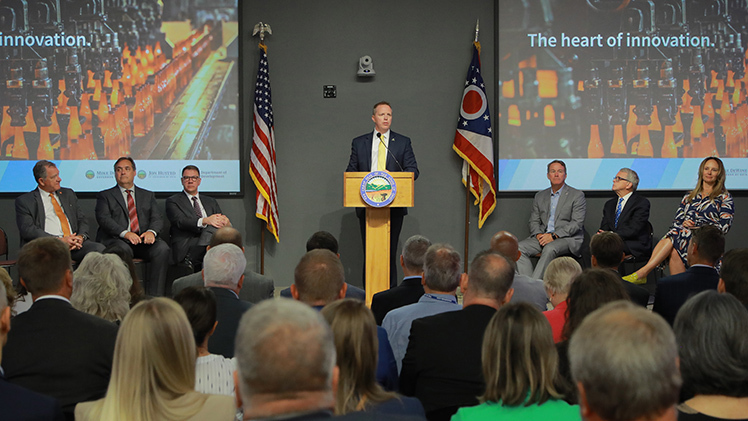
Revitalizing Northwest Ohio’s Glass Industry: A New Chapter in Materials Science and Economic Innovation
The glass industry, long celebrated for its resilience and innovation, has seen a renewed sense of purpose in northwest Ohio. Recent developments have ushered in a pivotal change—a welcome expert with a career rich in experience and research excellence. Dr. Donghui Zhao’s arrival at the University of Toledo marks not merely an addition to the academic roster, but a strategic bridge between industry needs and advanced technical research. His role as an associate professor, with dual responsibilities that span the College of Natural Sciences and Mathematics and the College of Engineering, positions him at the forefront of academic leadership at the newly established Northwest Ohio Glass Innovation Hub. This unique initiative is set to inject fresh ideas and practical program offerings into a sector already recognized for its pioneering contributions to glassmaking and solar energy technology.
With a robust investment of $31.3 million from the Ohio Department of Development, the region is poised to transform into a national hub for glass science and innovative material research. Dr. Zhao’s extensive background, which includes leadership roles in industry giants like Corning, Alkegen, and Saint-Gobain, will be instrumental in reigniting the region’s competitive edge. His appointment is both a testament to the university’s commitment to academic excellence and a strategic move to harness the technical expertise required to overcome many of the tricky parts and tangled issues that modern glass manufacturing faces.
Bridging Academia and Industry: Addressing Tricky Parts in Glass Manufacturing
At the heart of this initiative is a commitment to solving the confusing bits and complicated pieces that have long challenged the glass manufacturing process. Glass production, with its many twists and turns, is a sector where subtle details can mean the difference between failure and breakthrough. Dr. Zhao’s role is to serve as the critical bridge between academia and industry—a liaison who will work to ensure that the academic research carried out at UToledo translates into tangible improvements and cost reductions for industry partners.
Dr. Zhao’s appointment comes at a time when the industry is eager to address issues such as:
- Reducing energy consumption during the manufacturing process
- Improving material performance to meet new industry standards
- Enhancing production techniques to lower manufacturing costs
- Integrating advanced scientific research with practical, real-world applications
By addressing these areas, the Northwest Ohio Glass Innovation Hub has a clear mission: to use advanced materials science research to find innovative solutions to the tricky parts inherent in glassmaking. This collaborative approach is essential in an era where every subtle detail counts, and where both academic and industrial partners must work together to figure a path through both the obvious and hidden complexities of modern glass production.
Enhancing Economic Development Through Advanced Glass Research
Northwest Ohio has long been known as a center for progress and innovation. The establishment of the Glass Innovation Hub supports this reputation by ushering in a wave of economic development that promises to benefit the entire region. With Dr. Zhao at the helm, the initiative is expected to spur research and development projects that directly influence the local economy. By working closely with industrial partners, UToledo aims to improve performance metrics, reduce costs, and ultimately create a more robust local economy that can better respond to the tricky parts and tangled issues of a globalized market.
The economic impact of this initiative can be observed in several areas:
| Area of Impact | Potential Benefits |
|---|---|
| Job Creation | New roles in research, manufacturing, and technology development |
| Cost Efficiency | Innovative production methods reducing energy usage and overhead |
| Educational Opportunities | Advanced academic programs that prepare students for industry challenges |
| Industry Collaboration | Stronger ties between academia and manufacturing, fostering mutual growth |
These benefits create a ripple effect that not only enhances the glass industry but also provides valuable support to the wider business ecosystem in the region. The initiative’s direct focus on addressing the confusing bits and the gentle yet impactful twists and turns of glass production underscores the critical importance of aligning academic research with industry needs.
Integrating Advanced Academic Programs With Real-World Applications
The University of Toledo has taken deliberate steps to ensure that its academic offerings meet the tangible needs of industries like glass production. The launch of a new undergraduate materials science program is one of the flagship efforts under the leadership of Dr. Zhao. This program is designed to equip students with practical skills and hands-on experience that go beyond theory, ensuring that graduates are ready to contribute effectively to solving the challenging and sometimes nerve-racking issues that define today’s manufacturing environment.
Key features of the new academic program include:
- Curriculum development focused on the small distinctions of glass science and engineering
- Hands-on laboratory sessions at the Wright Center for Photovoltaics Innovation and Commercialization
- Collaborative projects that involve direct industry input and engagement
- Mentorship programs facilitated by top experts with a wealth of practical experience
By integrating these components into the curriculum, UToledo is preparing its students to engage with real-life challenges head-on. In doing so, the institution is not only fostering academic growth but also ensuring that future professionals are well-equipped to work through even the most intimidating or off-putting parts of the manufacturing process.
Fostering Industry Collaborations for Shared Success
One of the most encouraging aspects of this development is the strong commitment to industry collaboration. The Northwest Ohio Glass Innovation Hub is designed as a cooperative space where academia and industry come together to address common challenges. With major partners such as First Solar, Owens Corning, O-I Glass, Libbey, NSG/Pilkington North America, and PepsiCo on board, the initiative represents a broad cross-section of the manufacturing and energy sectors.
Working through the fine points of collaborative research, Dr. Zhao and his team will be engaging in projects aimed at:
- Developing new glass formulations and materials that cater to industry-specific needs
- Optimizing production processes to drive down costs and improve energy utilization
- Exploring renewable energy applications of advanced glass materials, particularly in solar technology
- Creating industry-tailored research projects that blend theoretical knowledge with practical outcomes
These collaborations are not just academic exercises. They represent a genuine commitment to finding solutions that address the confused bits and subtle challenges of glass production. By being anchored in real-world needs, every project at the Hub is intended to have a direct and positive impact on the local and national economy.
Leveraging Patent Innovation and Commercialization to Drive Industry Breakthroughs
Dr. Zhao’s impressive portfolio, featuring over 20 registered innovations with the U.S. Patent and Trademark Office, speaks volumes about his capacity to transfer scholarly research into market-ready products. His work, which includes successful commercialization ventures in advanced battery materials and specialized glass fibers, serves as a robust model for how research can be directly and effectively applied to solve industry problems.
This strategic approach to innovation is especially critical given the numerous challenging parts and tricky twists inherent in glass manufacturing. The potential for new technological breakthroughs is immense, and Dr. Zhao’s work could pave the way for:
- New production methodologies that significantly lower energy consumption
- Innovative glass products tailored to modern usage demands, including solar energy applications
- The development of more environmentally friendly manufacturing practices
- Strengthened intellectual property portfolios that drive long-term competitive advantage
Each of these elements contributes to a larger narrative: that proactive academic research, when aligned with industry needs, can generate profoundly positive changes for both the economy and the environment.
Economic and Technological Implications of the Glass Innovation Hub
The investment of $125 million by the Ohio Department of Development, aimed at boosting regions outside major metropolitan areas, underscores the belief in northwest Ohio’s capacity for transformative growth. The Glass Innovation Hub stands out as a beacon of technological advancement and economic revitalization. By nurturing a culture of continuous improvement and practical innovation, the Hub will serve as the engine driving lasting prosperity—a prospect that many local industries find both exciting and critically important.
Key economic and technological implications include:
- Enhanced Competitiveness: The region’s industries will have access to cutting-edge research, helping them compete on a global stage.
- Focused Economic Growth: Targeted investment in glass research spurs job creation and attracts additional business ventures.
- Technological Advancements: Harnessing the synergy between academic research and industrial needs to pave the way for next-generation glass products.
- Sustainable Practices: Development of environmentally friendly manufacturing techniques that reduce energy usage and carbon footprints.
This alignment of community and industry is driving a transformation that goes far beyond the periodic production of glass. It’s about setting a blueprint for regional economic revitalization and demonstrating that when academic institutions and industrial partners work together in a harmonious way, they can overcome even the nerve-racking and off-putting challenges that sometimes seem insurmountable.
Transforming the Future of Glass Science Through Hands-On Learning
The importance of hands-on research and learning experiences cannot be understated in today’s educational environments. The new academic programs at UToledo are designed with a clear focus on practical, industry-relevant skills. Students are not only expected to learn theory; they are also given the opportunity to work directly in state-of-the-art laboratories—such as the Wright Center for Photovoltaics Innovation and Commercialization—where real-world challenges are tackled head-on.
Emphasizing the little details and fine shades of glass research, these academic programs enable students to:
- Figure a path through tricky laboratory techniques that mirror industry processes
- Work with actual production materials and modern equipment
- Engage in interdisciplinary projects that combine principles of physics, engineering, and materials science
- Gain exposure to the large-scale collaborative efforts that mirror the operations of major industrial players
This immersive learning environment helps students address the tricky bits of theoretical and practical issues, ensuring they are well-prepared to meet industry standards once they transition into professional roles. Furthermore, these hands-on experiences instill a sense of responsibility toward solving the confusing bits that illustrate the challenges of modern manufacturing processes.
The Broader Impact on Regional Innovation and Workforce Development
The significance of having an industry leader like Dr. Zhao onboard extends well beyond academia—its ripple effects will be felt throughout the local business community and the broader regional economy. As Northwest Ohio positions itself as a key hub for glass science and engineering, the benefits of these advancements will be experienced in multiple areas, including workforce development and regional innovation.
Some of the broader impacts include:
| Impact Area | Expected Outcome |
|---|---|
| Workforce Upskilling | High-quality training programs that help individuals retool for new opportunities |
| Industry-Academic Synergies | Collaborative projects that generate practical outcomes and technological breakthroughs |
| Local Economic Stimulus | Increased job creation and higher workforce retention rates |
| Innovation Ecosystem | A vibrant community of research, development, and entrepreneurial initiatives |
These dimensions of impact are essential not just for the glass industry, but for the broader ambition of making the region a national leader in innovation. As new technologies unfold and businesses seek to figure a path through the ever-changing marketplace, initiatives like the Northwest Ohio Glass Innovation Hub provide a model on how to effectively work through both academic and industrial challenges together.
Looking Ahead: A Collaborative Path to Future Breakthroughs
The future of glass science in northwest Ohio is bright, bolstered by a combination of academic leadership, robust industrial partnerships, and proactive governmental support. Dr. Zhao’s strategic appointment is a call to action for both sectors—to come together and address even the most intimidating or overwhelming parts of the manufacturing process. His proven track record stands as an assurance that the region is well-equipped to handle the subtle parts of glass innovation and production that have historically been riddled with tension and on-edge challenges.
In practical terms, the collaborative model introduced by the Northwest Ohio Glass Innovation Hub is built on the following pillars:
- Industry Relevance: Aligning research projects with real-world challenges to create solutions that matter.
- Academic Rigor: Employing research methodologies that rigorously test and validate new techniques and materials.
- Community Engagement: Encouraging broader community involvement through educational programs, workshops, and events.
- Sustainable Innovation: Focusing on energy-efficient and environmentally responsible production methods.
Each of these pillars supports a structure that is not only flexible enough to adapt to unexpected twists and turns—those confusing or intimidating parts of any industrial process—but is also sturdy enough to support sustained growth and development over the coming decades. This kind of vision is what drives communities to take a closer look at their existing resources, innovate boldly, and push the boundaries of what is possible in terms of technological advancement and economic growth.
Building a Future-Proof Glass Industry: Insights and Recommendations
As we take a closer look at the strategies emerging from this initiative, several recommendations stand out for stakeholders in both academia and industry. First and foremost, fostering an environment where research and practical applications inform each other is critical. The intricate balance between academic theory and industrial practice creates a fertile ground for breakthroughs—particularly in fields as technically challenging and creatively demanding as glass production.
For industry leaders considering similar collaborations, here are some actionable insights:
- Invest in R&D: Consistent and targeted research funding can help overcome even the most intimidating challenges in production.
- Encourage Cross-Sector Collaboration: Regular joint ventures, workshops, and innovation summits create opportunities to figure a path through both obvious and hidden technical complexities.
- Develop Talent Early: Academic programs that combine hands-on learning with real industry challenges prepare the next generation of innovators to make a real-world impact.
- Maintain Flexibility: As industry needs evolve, so must research priorities. An adaptive strategy allows for quick responses to sudden changes or unexpected challenges.
In summary, taking these steps will not only benefit the immediate stakeholders but also contribute to a national narrative that values innovation, resilience, and collaborative success. The subtle details and little twists involved in managing tough projects can be transformed into key strengths when tackled by a well-coordinated team that truly understands the interplay between academic rigor and practical necessity.
Reflections on the Role of Innovation Hubs in Regional Development
The initiative taken by UToledo and the Northwest Ohio Innovation Consortium exemplifies a bold vision for the future. It demonstrates that when regional universities join forces with industry veterans and support from governmental agencies, the outcomes can be transformative. The Glass Innovation Hub serves as a microcosm illustrating how educational institutions can energize local economies, attract new businesses, and even spur technological advancements on a national scale.
Observations from similar innovation hubs across the country suggest that:
- Collaborative environments are essential for overcoming tricky parts and tangled issues in traditional industries.
- An emphasis on hands-on experiences and real-world projects helps mitigate the overwhelming challenges associated with rapid technological change.
- A focus on sustainable development and environmentally friendly practices not only benefits the industry but also aligns with broader societal goals.
These observations underscore that the model embraced in northwest Ohio is not an isolated example but rather part of a growing trend where regional innovation centers become crucibles for breakthroughs, proving that academic-industry partnerships are a must-have in today’s competitive landscape.
Conclusion: The Promise of a Brighter Future for Glass Science and Economic Development
In conclusion, the arrival of Dr. Donghui Zhao at UToledo heralds a significant shift in the landscape of glass manufacturing in northwest Ohio. His appointment is emblematic of a broader mission: to harness the collective expertise of academia, industry, and government in order to meet—and overcome—the challenging and sometimes overwhelming parts of modern glass production. By addressing the subtle details and complicated pieces head-on, the Northwest Ohio Glass Innovation Hub is positioned to foster breakthroughs that could reshape the industry for years to come.
The initiative’s success will likely serve as a blueprint for similar projects across the country, showing that when academic institutions and industrial partners work together, they can not only figure a path through tricky bits and confusing twists but also drive sustainable regional growth. From cutting-edge research to practical production improvements, every aspect of this collaboration contributes to a future where innovation and economic development walk hand in hand.
As stakeholders from various sectors continue to engage in this exciting venture, the wider community stands to benefit enormously—from improved job prospects and enhanced educational programs to an invigorated economy that embraces both tradition and modernity. The coming years promise to be an exhilarating period of transformation, where the fusion of deep research expertise and applied industrial knowledge paves the way for extraordinary achievements in glass science.
Ultimately, the story of northwest Ohio’s Glass Innovation Hub is a vivid reminder that progress is best achieved through coordinated efforts and by embracing both the obvious challenges and the hidden complexities of our modern industrial landscape. With leaders like Dr. Zhao steering the course, the region is set to become a national leader in glass research and innovation—a prospect that inspires hope and confidence for a brighter, more innovative future.
Originally Post From https://news.utoledo.edu/index.php/10_27_2025/utoledo-northwest-ohio-innovation-consortium-welcome-glass-industry-expert
Read more about this topic at
Glass is Elevating Interior Design | The Glass Age
Vitro Architectural Glass Introduces Spandrelite™ Glass to …


